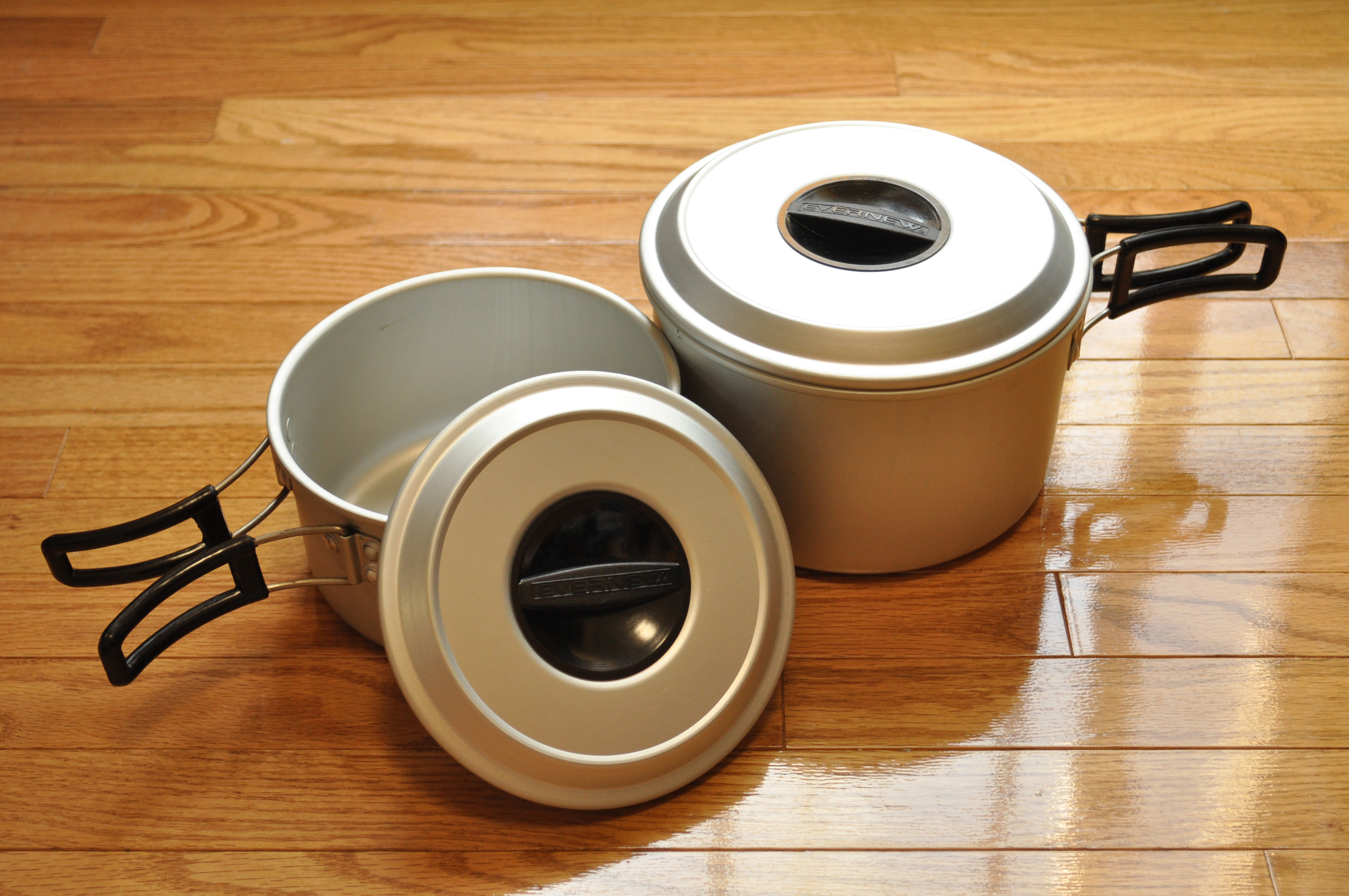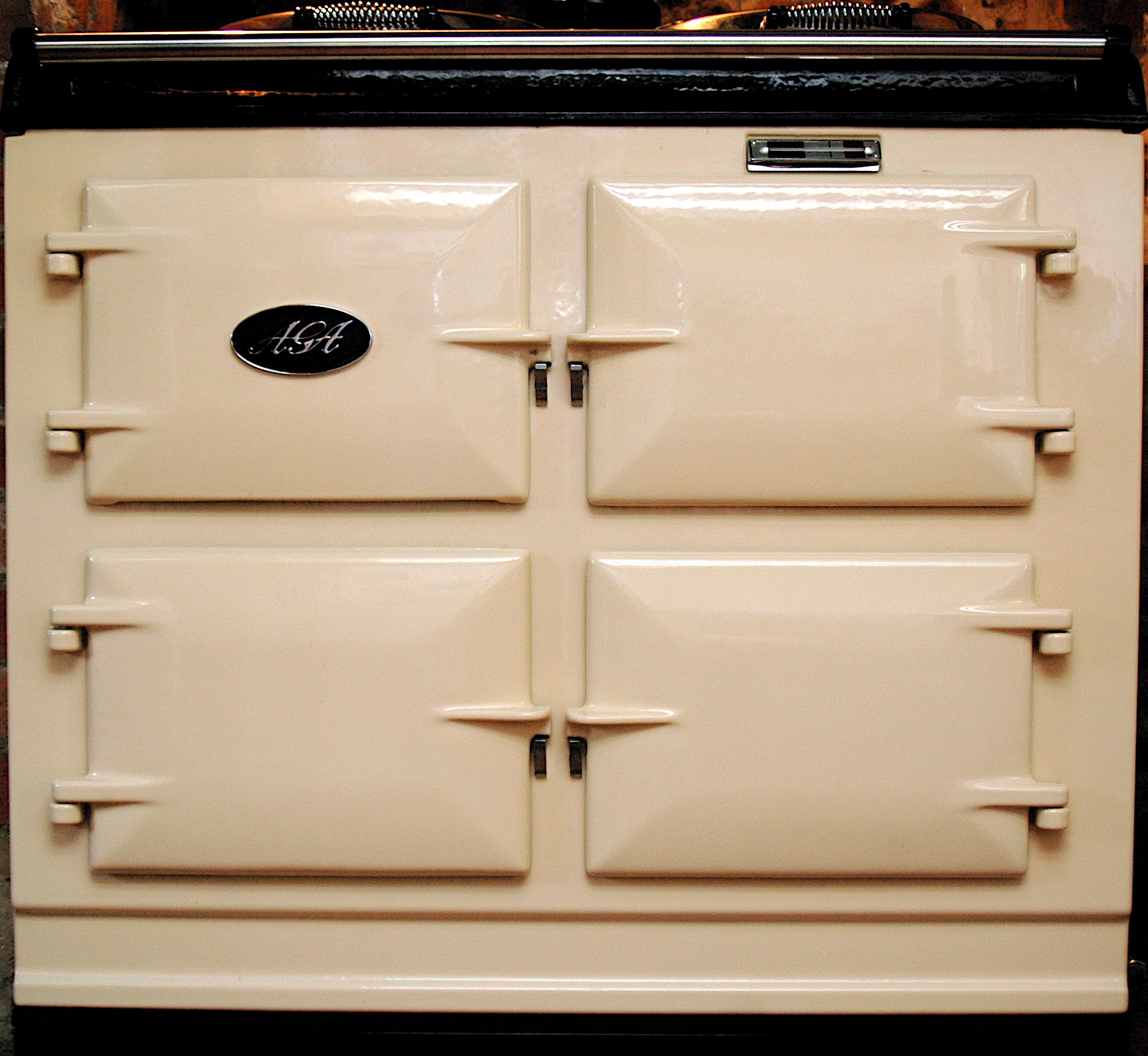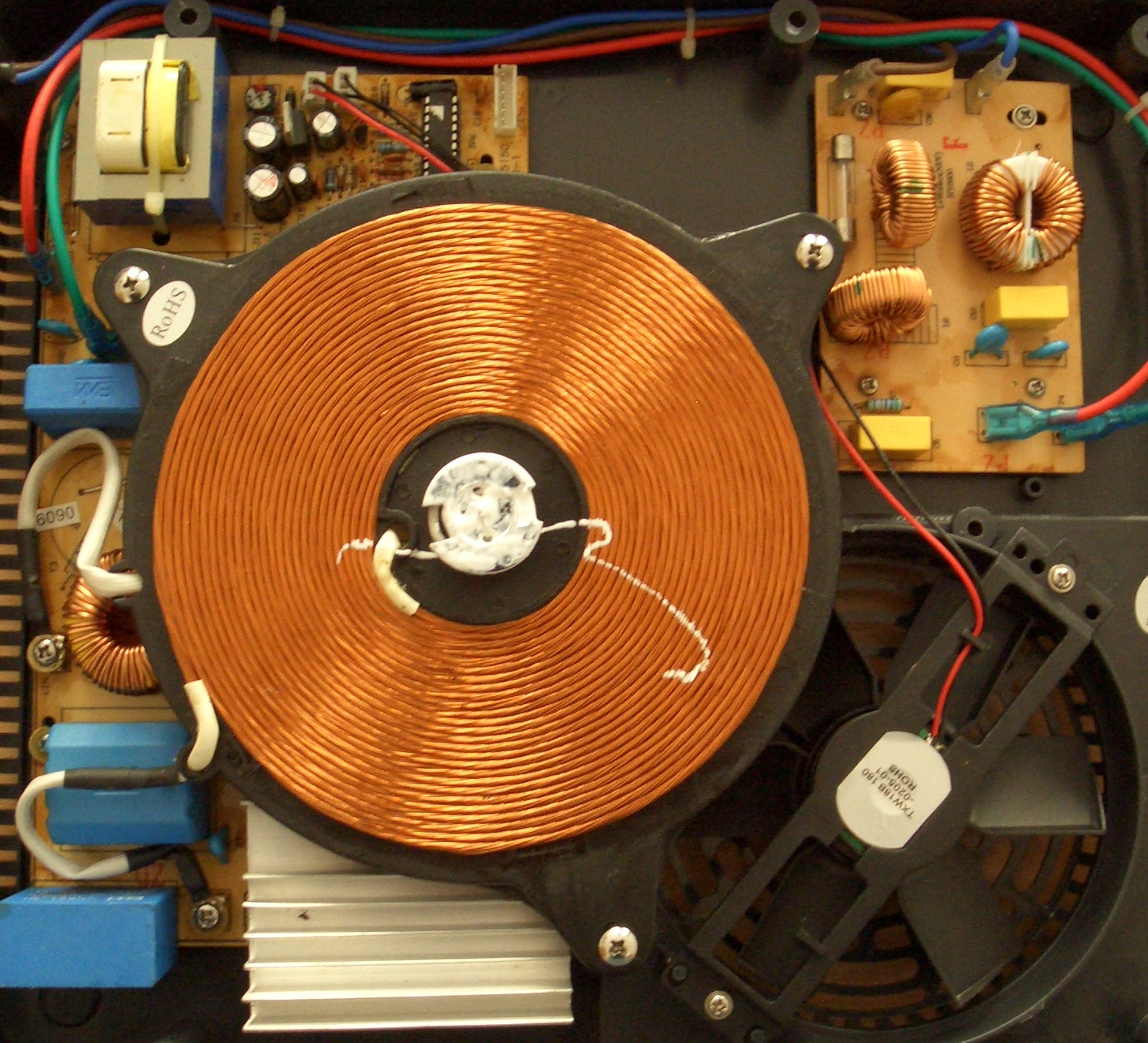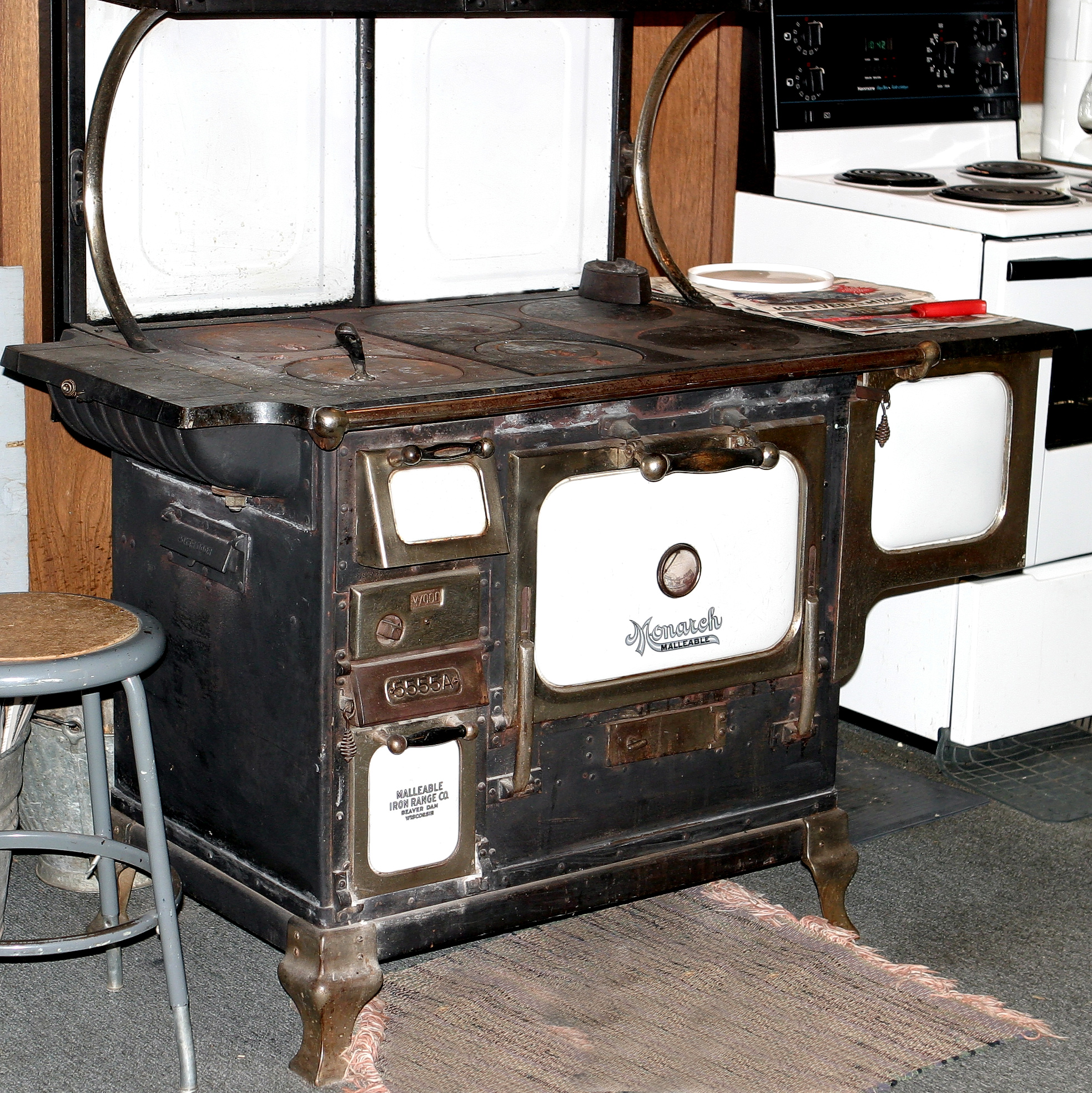|
Cooker
Cooker may refer to several types of cooking appliances and devices used for cooking foods. Cookers * AGA cooker – a heat storage stove and cooker, which works on the principle that a heavy frame made from cast iron components can absorb heat from a relatively low-intensity but continuously-burning source, and the accumulated heat can then be used when needed for cooking. Originally heated by slow-burning coal, the Aga cooker was invented in 1922 by the Nobel Prize-winning Swedish physicist Gustaf Dalén (1869–1937), who was employed first as the chief engineer of the Swedish AGA company. * Cook stove – heated by burning wood, charcoal, animal dung or crop residue. Cook stoves are commonly used for cooking and heating food in households that lack access to clean, modern facilities for cooking. * Electric cooker – an electric powered cooking device for heating and cooking of food * Gas stove (British English) – uses natural gas, propane, butane, liquefied petroleum ... [...More Info...] [...Related Items...] OR: [Wikipedia] [Google] [Baidu] |
Cooker
Cooker may refer to several types of cooking appliances and devices used for cooking foods. Cookers * AGA cooker – a heat storage stove and cooker, which works on the principle that a heavy frame made from cast iron components can absorb heat from a relatively low-intensity but continuously-burning source, and the accumulated heat can then be used when needed for cooking. Originally heated by slow-burning coal, the Aga cooker was invented in 1922 by the Nobel Prize-winning Swedish physicist Gustaf Dalén (1869–1937), who was employed first as the chief engineer of the Swedish AGA company. * Cook stove – heated by burning wood, charcoal, animal dung or crop residue. Cook stoves are commonly used for cooking and heating food in households that lack access to clean, modern facilities for cooking. * Electric cooker – an electric powered cooking device for heating and cooking of food * Gas stove (British English) – uses natural gas, propane, butane, liquefied petroleum ... [...More Info...] [...Related Items...] OR: [Wikipedia] [Google] [Baidu] |
Extractor Hood
A kitchen hood, exhaust hood, extractor hood, or range hood is a device containing a mechanical fan that hangs above the stove or cooktop in the kitchen. It removes airborne grease, combustion products, fumes, smoke, heat, and steam from the air by evacuation of the air and filtration. In commercial kitchens exhaust hoods are often used in combination with fire suppression devices so that fumes from a grease fire are properly vented and the fire is put out quickly. Commercial vent hoods may also be combined with a fresh air fan that draws in exterior air, circulating it with the cooking fumes, which is then drawn out by the hood. In most exhaust hoods, a filtration system removes grease (the grease trap) and other particles. Although many vent hoods exhaust air to the outside, some recirculate the air to the kitchen. In a recirculating system, filters may be used to remove odors in addition to the grease. The device is known as an extractor hood in the United Kingdom, as a rang ... [...More Info...] [...Related Items...] OR: [Wikipedia] [Google] [Baidu] |
AGA Cooker
The AGA cooker oven is a Swedish oven and cooker. Invented and initially produced in Sweden, since 1957 all production has been located in the UK. History Originally developed to burn coal or anthracite, the Aga cooker was invented in 1922 by the Nobel Prize-winning Swedish physicist Gustaf Dalén (1869–1937), who was employed as the chief engineer of the Swedish AGA company ( Swedish ''Svenska Aktiebolaget Gasaccumulator'', English ''Swedish Gas Accumulator, Limited''). Dalén lost his sight in an explosion while developing his earlier invention, a porous substrate for storing gases, Agamassan. Forced to stay at home, Dalén discovered that his wife was exhausted by cooking. Although blind, he set out to develop a new stove that was capable of a range of culinary techniques and easy to use. Adopting the principle of heat storage, he combined a heat source, two large hotplates and two ovens into one unit: the AGA Cooker. The cooker was introduced to the United Kingdom i ... [...More Info...] [...Related Items...] OR: [Wikipedia] [Google] [Baidu] |
Electric Cooker
An electric cooker is an electric powered cooking device for heating and cooking of food. An electric cooker often has four stoves and one or two ovens. There will be knobs to determine the temperature of the ovens and stoves. Unlike gas stoves that are powered by gas, it is powered by electricity. Usually they have four rings on top of the hob, similar to most gas cookers. Besides stoves or ranges, common types include hot plates, slow cookers (or crock pots), electric toasters, rice cookers, electric teakettles, and the now obsolete Dub Cookers. See also *Cooker *Electric stove An electric stove or electric range is a stove with an integrated electrical heating device to cook and bake. Electric stoves became popular as replacements for solid-fuel (wood or coal) stoves which required more labor to operate and maintain. ... References Cooking appliances {{Cooking-tool-stub ... [...More Info...] [...Related Items...] OR: [Wikipedia] [Google] [Baidu] |
Cooking
Cooking, cookery, or culinary arts is the art, science and craft of using heat to prepare food for consumption. Cooking techniques and ingredients vary widely, from grilling food over an open fire to using electric stoves, to baking in various types of ovens, reflecting local conditions. Types of cooking also depend on the skill levels and training of the cooks. Cooking is done both by people in their own dwellings and by professional cooks and chefs in restaurants and other food establishments. Preparing food with heat or fire is an activity unique to humans. Archeological evidence of cooking fires from at least 300,000 years ago exists, but some estimate that humans started cooking up to 2 million years ago. The expansion of agriculture, commerce, trade, and transportation between civilizations in different regions offered cooks many new ingredients. New inventions and technologies, such as the invention of pottery for holding and boiling of water, expanded cooking ... [...More Info...] [...Related Items...] OR: [Wikipedia] [Google] [Baidu] |
Induction Cooking
Induction cooking is performed using direct induction heating of cooking vessels, rather than relying on indirect radiation, convection, or thermal conduction. Induction cooking allows high power and very rapid increases in temperature to be achieved, and changes in heat settings are instantaneous. In an induction stove (also "induction hob" or "induction cooktop"), a cooking vessel with a ferromagnetic base is placed on a heat-proof glass-ceramic surface above a coil of copper wire with an alternating electric current passing through it. The resulting oscillating magnetic field wirelessly induces an electrical current in the vessel. This large eddy current flowing through the resistance of a thin layer of metal in the base of the vessel results in resistive heating. For nearly all models of induction cooktops, a cooking vessel must be made of, or contain, a ferrous metal such as cast iron or some stainless steels. The iron in the pot concentrates the current to produce he ... [...More Info...] [...Related Items...] OR: [Wikipedia] [Google] [Baidu] |
Kitchen Stove
A kitchen stove, often called simply a stove or a cooker, is a kitchen appliance designed for the purpose of cooking food. Kitchen stoves rely on the application of direct heat for the cooking process and may also contain an oven, used for baking. "Cookstoves" (also called "cooking stoves" or "wood stoves") are heated by burning wood or charcoal; "gas stoves" are heated by gas; and "electric stoves" by electricity. A stove with a built-in cooktop is also called a range. In the industrialized world, as stoves replaced open fires and braziers as a source of more efficient and reliable heating, models were developed that could also be used for cooking, and these came to be known as ''kitchen stoves''.Montagne, Prosper ''New Larousse Gastronomique'' Hamlin Publishing Group 1977 268,901 Quoting Eugène Viollet-le-Duc on cooking in the Middle Ages: "The division of stoves into several compartments as in our day was seldom seen. The dishes were cooked on the fire itself, and these f ... [...More Info...] [...Related Items...] OR: [Wikipedia] [Google] [Baidu] |
Stove
A stove or range is a device that burns fuel or uses electricity to generate heat inside or on top of the apparatus, to be used for general warming or cooking. It has evolved highly over time, with cast-iron and induction versions being developed. Stoves can be powered with many fuels, such as electricity, gasoline, wood, and coal. Due to concerns about air pollution, efforts have been made to improve stove design. Pellet stoves are a type of clean-burning stove. Air-tight stoves are another type that burn the wood more completely and therefore, reduce the amount of the combustion by-products. Another method of reducing air pollution is through the addition of a device to clean the exhaust gas, for example, a filter or afterburner. Research and development on safer and less emission releasing stoves is continuously evolving. Etymology The term "stove" is derived from the Old English word ''stofa'', indicating any individual enclosed space or room; "stove" may sometimes stil ... [...More Info...] [...Related Items...] OR: [Wikipedia] [Google] [Baidu] |
Coal
Coal is a combustible black or brownish-black sedimentary rock, formed as rock strata called coal seams. Coal is mostly carbon with variable amounts of other elements, chiefly hydrogen, sulfur, oxygen, and nitrogen. Coal is formed when dead plant matter decays into peat and is converted into coal by the heat and pressure of deep burial over millions of years. Vast deposits of coal originate in former wetlands called coal forests that covered much of the Earth's tropical land areas during the late Carboniferous ( Pennsylvanian) and Permian times. Many significant coal deposits are younger than this and originate from the Mesozoic and Cenozoic eras. Coal is used primarily as a fuel. While coal has been known and used for thousands of years, its usage was limited until the Industrial Revolution. With the invention of the steam engine, coal consumption increased. In 2020, coal supplied about a quarter of the world's primary energy and over a third of its electricity ... [...More Info...] [...Related Items...] OR: [Wikipedia] [Google] [Baidu] |
Butane
Butane () or ''n''-butane is an alkane with the formula C4H10. Butane is a gas at room temperature and atmospheric pressure. Butane is a highly flammable, colorless, easily liquefied gas that quickly vaporizes at room temperature. The name butane comes from the root but- (from butyric acid, named after the Greek word for butter) and the suffix -ane. It was discovered by the chemist Dr. Walter Snelling in 1912. It was found dissolved in crude petroleum in 1864 by Edmund Ronalds, who was the first to describe its properties. Butane is one of a group of liquefied petroleum gases (LP gases). The others include propane, propylene, butadiene, butylene, isobutylene, and mixtures thereof. Butane burns more cleanly than gasoline and coal. Density The density of butane is highly dependent on temperature and pressure in the reservoir. For example, the density of liquid phase is 571.8±1 kg/m3 (for pressures up to 2MPa and temperature 27±0.2 °C), while the density of l ... [...More Info...] [...Related Items...] OR: [Wikipedia] [Google] [Baidu] |
Ferromagnetic
Ferromagnetism is a property of certain materials (such as iron) which results in a large observed magnetic permeability, and in many cases a large magnetic coercivity allowing the material to form a permanent magnet. Ferromagnetic materials are the familiar metals noticeably attracted to a magnet, a consequence of their large magnetic permeability. Magnetic permeability describes the induced magnetization of a material due to the presence of an ''external'' magnetic field, and it is this temporarily induced magnetization inside a steel plate, for instance, which accounts for its attraction to the permanent magnet. Whether or not that steel plate acquires a permanent magnetization itself, depends not only on the strength of the applied field, but on the so-called coercivity of that material, which varies greatly among ferromagnetic materials. In physics, several different types of material magnetism are distinguished. Ferromagnetism (along with the similar effect ferrimagneti ... [...More Info...] [...Related Items...] OR: [Wikipedia] [Google] [Baidu] |
Heat Transfer
Heat transfer is a discipline of thermal engineering that concerns the generation, use, conversion, and exchange of thermal energy (heat) between physical systems. Heat transfer is classified into various mechanisms, such as thermal conduction, thermal convection, thermal radiation, and transfer of energy by phase changes. Engineers also consider the transfer of mass of differing chemical species (mass transfer in the form of advection), either cold or hot, to achieve heat transfer. While these mechanisms have distinct characteristics, they often occur simultaneously in the same system. Heat conduction, also called diffusion, is the direct microscopic exchanges of kinetic energy of particles (such as molecules) or quasiparticles (such as lattice waves) through the boundary between two systems. When an object is at a different temperature from another body or its surroundings, heat flows so that the body and the surroundings reach the same temperature, at which point they are in ... [...More Info...] [...Related Items...] OR: [Wikipedia] [Google] [Baidu] |







